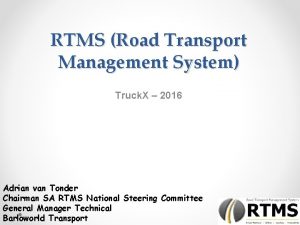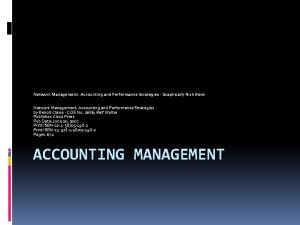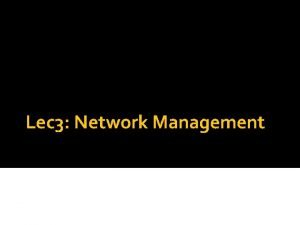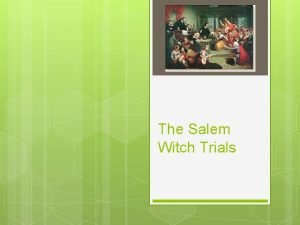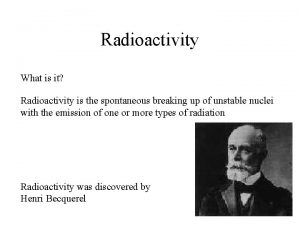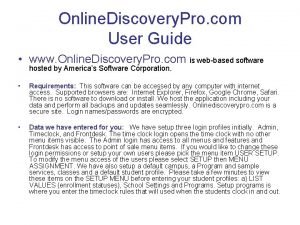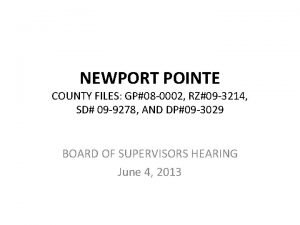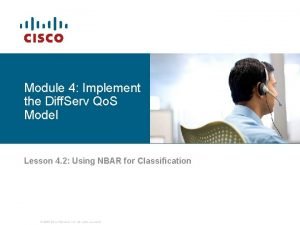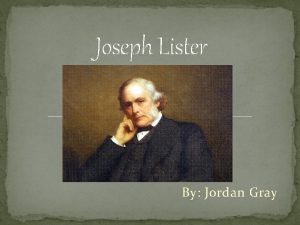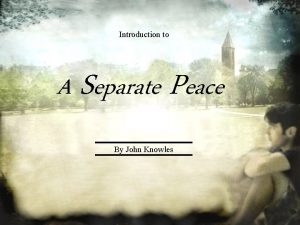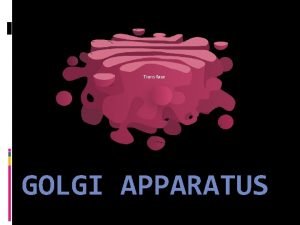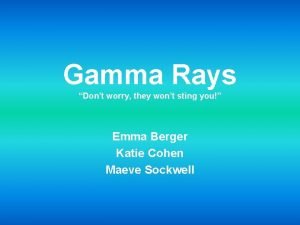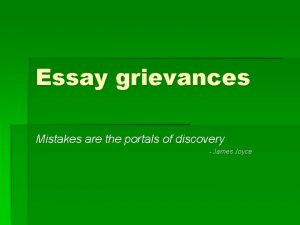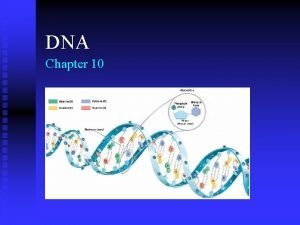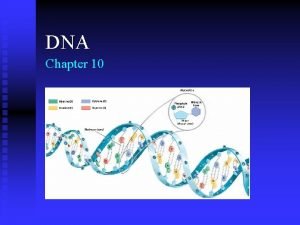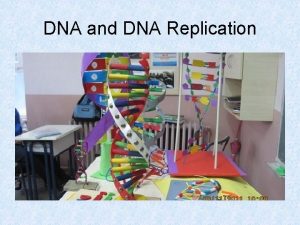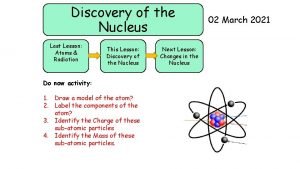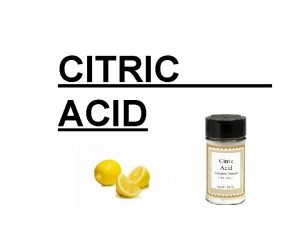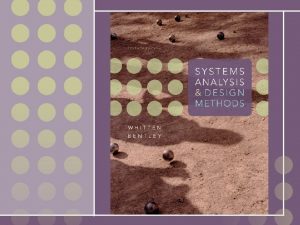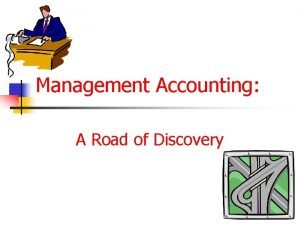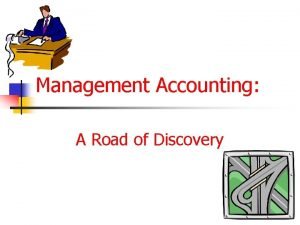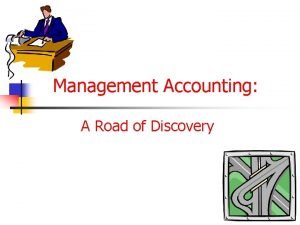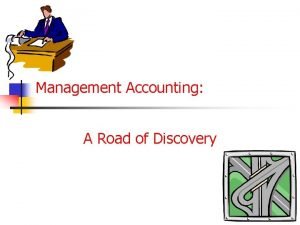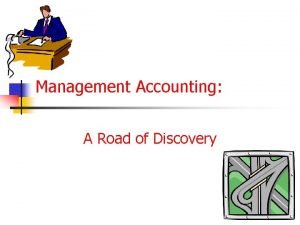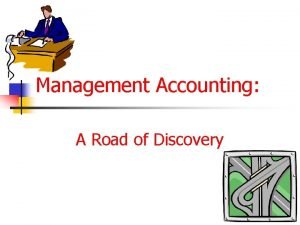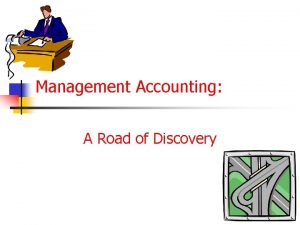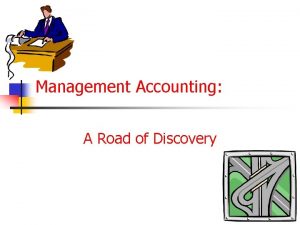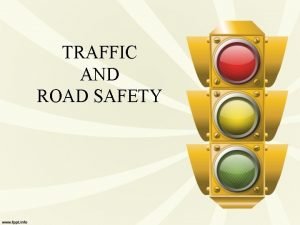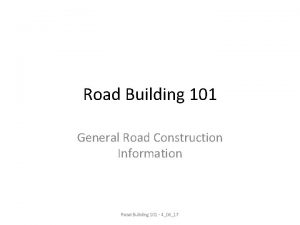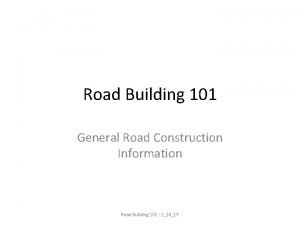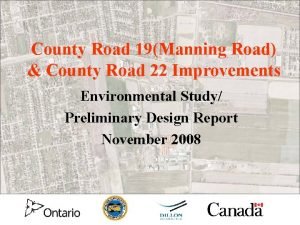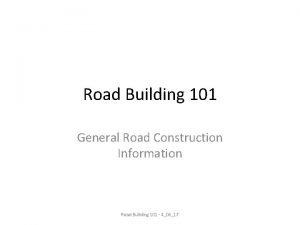Management Accounting A Road of Discovery Management Accounting














































- Slides: 46

Management Accounting: A Road of Discovery

Management Accounting: A Road of Discovery James T. Mackey Michael F. Thomas Presentations by: Roderick S. Barclay Texas A&M University - Commerce James T. Mackey California State University - Sacramento © 2000 South-Western College Publishing

Chapter 6 Are we following the plan? The need for variance analysis

Key Learning Objectives • Explain management by exception and how it is a feedback system. • Calculate and interpret the sales price and volume variances. • Define the components of a standard cost card, and list its benefits and limitations. • Calculate and interpret spending and usage variances. • Distinguish between boardroom and process control, and explain the usefulness of variance analysis for these strategies. • Compare ideal and practical standards, and explain why practical standards represent the “one best way”.

PART I THE COMPANY AS A WELL DESIGNED MACHINE FOR MANAGEMENT BY THE NUMBERS

The Company n n Each Responsibility Center is a separate part of the whole company. ‘Management by Exception’ — MBE or variances from the plan. n n n Means we only interfere if the plan is not being met. Managers can ‘drill down’ into variance reports that show what resources were used during the period. Variances change the ‘black box’ into a ‘glass box’.

The Role of Budgets for Management by Exception n n Accounting reports are hard data. Accounting reports are designed to examine responsibility centers or functional departments. Accounting reports provide information on the use of resources within each department. The variances for each resource are equal to the change in budgeted profit! Note: See Exhibit 6 -2, p. 191 for an example of a Profit Variance Report.

PART II RELIABLE BUDGET MEASURES

Efficient MBE Relies on Accurate Budgeting n n The plan is only as good as the data that goes into it — Garbage in = Garbage out! How we make sure that the data used to plan is correct. n n Use engineered or ‘the one best way’ standards with Scientific Management. The focus is on designing and maintaining ‘one best way’ standards. Not all budgets may be scientifically designed, but they are contracts between responsibility center managers and the company. In practice the input data and the standards behind them vary in degree of accuracy but responsibility center managers have committed to meeting these performance levels during the planning period.

Work and Price Standards n n Engineered standards describe the best way to perform an activity and the materials needed to complete the product. Good management means making sure activities follow these rules!

Example Concrete Bird Baths Standard Cost Card Direct materials — 50 lbs @ $3 Direct labor — 2 hours @ $10 Manufacturing overhead: Variable — 2 DL hours @ $5 POR Fixed — 2 DL hours @ $12. 50 POR = $150 = 20 Standard unit cost = $200 = = 5 25

More Work and Price Standards n n Budgeting and Scientific Management systems insure the original data is reliable. Variances obtained from accounting reports allow MBE practices. n n Variance are the differences between actual and planned results. Variances measure the impact on target profit. Variance identify which resources were not used as planned — Which activities to investigate first! Variance reports allow management to drill down into the organization to examine t 6 he performance of each responsibility center and its use of resources.

PART III HOW DO VARIANCE REPORTS EXPLAIN SARAH’S COLLEGE DILEMMA?

Sarah’s Earnings (revenue) Variances Wages earned: Hours Worked: (Actual – Budgeted rate) x Actual Vol. ($8 / hr = $10 / hr) x 440 hours (Actual – Budgeted hours) x Budget rate (440 hours – 400 hours) x $ 10 / hr Total Earnings Variance: = = ($880)U = $400 F ($480)U NOTE: F = favorable, U = unfavorable, or earned more (F) or less (U) than planned.

Sarah’s Cost Variances Tuition rate: Hours Worked: (Budgeted - Actual rate) x Actual Vol. ($50 / credit - $60 / credit) x 15 credits (Budgeted – Actual credits) x Budget rate (16 credits – 15 credits ) x $ 50 / credit Total Tuition Variance: = = ($150)U = $ 50 F ($100)U NOTE: Cost more (U) or less (F) than planned.

Analysis of Sarah’s Dilemma n n n n She worked at a lower wage rate than planned — $10 - $8. She worked more hours than planned — 400 – 440. Cost changes are due to tuition rate changes — $50 – 460. She isn’t taking as many credits as planned — 16 – 15. Favorable variances (F) helped her budget. Unfavorable variances (U) worsened her budget. Relative impact: n Total tuition variance — $100 U n Wages earned — $880 U n Hours worked — $400 F n Tuition price — $150 U n Credits taken — $50 F The budget report allows you to ‘drill down’ into the process to examine the reasons for her missing the budget.

What Does Sara’s Dilemma Tell Us? n n n If Sara had analyzed her situation sooner she could possibly have lessened her difficulties. Sara tried to solve her own difficulties, she did not seek help. (This is a typical business situation. ) Sara adapted to her situation — that is good, but with help it might have been better. (A good business lesson. ) If her actions were more visible, that would probably have affected her behavior positively. (Another good business lesson. ) Variance analysis tends to move Sara’s actions from a ‘black box’ to a ‘glass box’ by providing more information about her activities and providing a better control environment. (A lesson for business management. )

Use our Knowledge to Analyze Multree’s Home Profit Variance for February n n n See Exhibit 6 -2, p. 189. Favorable or unfavorable means the variance increased our actual profits or decreases our actual profit respectively. Standards allow companies to use flexible proforma budgets within the relevant range. For MBE, what function or functions would you investigate? Remember, these are the costs within our relevant range. Thus these are unit based (linear) costs that we can use at any volume.

PART IV Calculating Variances for Bird Baths

Variable Cost Variances n n In the past month 800 units were produced and the cost of materials was $123, 500 (38, 000 lbs @ $3. 25) but the budgeted costs for this level are $120, 000. The budgeted costs are calculated by multiplying the standard for one unit by the volume of work completed. That is, the standard for materials is $3 x 50 lbs multiplied by 800 completed units.

Variable Cost Variances (Continued) Variable Costs Actual Costs ‘Inputs’ Budgeted Cost Variances Costs ‘Outputs’ Direct Materials $3. 25 X 38, 000 lb s=$123, 500 800($3 x 50 lbs) =$120, 000 $3, 500 Unfavorable The ‘Unfavorable direct materials variance reduces the target profit by $3, 500. We can drill down and break this variance into the two components: Price and Quantity.

Price Variances n n Materials Price variances — the differences between the actual and standard purchase price multiplied by the materials used. Where: n n n n PS = Standard price per unit of inputs. PA = Actual price per unit of inputs. QS = The budgeted resources for one unit. QA = The actual resources consumed in total X = Volume of good produced. Variances due to price of materials = (PA-PS)QA. (Actual-Standard prices)Materials used = ($3. 25 -$3. 00)38, 000 = $9, 500 Unfavorable. Because we paid more than planned, our target profit is reduced by $9, 500.

Usage or Efficiency Variances n n Variance due to materials used = (actual inputs x standard prices) – (standard input x standard prices) x good outputs. Materials Usage and Efficiency variances = PSQA – PSQSx. n n Therefore: Material Usage variance = $3. 00 x 38, 000 lbs -$3. 00 x 50 lbs x 800 units = $6, 000 F That is: 38, 000 lbs used versus (800 units x 50 lbs) 40, 000 lbs that should have been used! The usage variance cost is (40, 00 vs. 38, 000) or 2000 lbs at the standard cost of $3 / lb or $6, 000 F Thus our net impact on profit due to materials variances is the price variance plus the usage variance or 49, 500 U + $6, 000 F = $3, 500 U.

Usage or Efficiency Variances Summary. n We have drilled down into the company to find the causes for the variances. Purchasing and manufacturing are separate Responsibility Centers. One has increased target profits, the other hast not. Now it may not be their fault, but the variances at least tell us where to ask questions for Management by Exception.

The General Formula The same Formula can be applied to all variable costs Variable Variances PAQA vs. PSQA PQA vs. PSQSx Direct materials Purchase price variance Usage variance Direct labor Rate variance Variable overhead Spending variance Efficiency variance

Fixed Cost Variances n Drilling down into fixed costs. n Fixed costs do not change with variation in volume. However, they can change because of nonvolume related activities, like the weather, or a tax ruling, etc. Therefore, we are interested in the difference between actual and budgeted fixed overhead for manufacturing costs.

Where Monthly Costs Are: Actual fixed overhead Fixed overhead recorded in the spending variance general ledger Budgeted monthly fixed overhead $20, 000 1/12 x $300, 000 = $25, 000 $5, 000 F

More Monthly Costs We can calculate the fixed costs for Administration and Selling Actual administration Spending variance Budgeted $10, 000 Actual sales $10, 000 None $10, 000 Spending variance Budgeted None $10, 000

Additional Fixed Manufacturing Variance Caused by GAAP n n Full costing means we have to ‘capitalize’ manufacturing costs into inventory accounts — product costs. When the work done is not the same as budgeted for the month, a “volume variance” occurs. Illustration: n n The predetermined overhead rate is $300, 00/12, 000 units at 23 hours each = $12. 50 per direct labor hour. This is the absorption or full costing accounting convention. If production is scheduled to be the same every month, then $25, 000 is budgeted monthly ($300, 000/12). (Continued)

Additional Fixed Manufacturing Variance Caused by GAAP (illustration continued) Budgeted fixed overhead Fixed overhead volume variance Fixed overhead applied using POR for GAAP 1/12 x $300, 000 = $25, 000 $5, 000 less than planned or favorable POR(QS)x = $12. 50 x 2 hrs x 800 units = $20, 000

Sales Variances: Sales Price Variances n n n Sales price variance = (PA – PS) QA Where: The budgeted sales price is PS, the actual sales price is PA and the actual sales volume is QA. Sales price variance = (PA – PS) QA = ($280 - $275) 800 = $4, 000 F

Sales Variances: Sales Volume Variances n n Changes in the contribution margin directly changes profits. Chanes in variable costs are already included in the previous variances. Thus, sales price changes are equal to contribution margin changes. For the sales volume variance, we use the standard contribution margin SCM. Sales volume variance = (Actual Volume – Budgeted Volume) SCM. = (800 – 1, 000) $95 = $19, 000 U

PART V Calculating Work Standards: The One Best Way

Calculating Work Standards n n How do we set standards? What are standard costs? Remember the Scientific Method. Standards are set from designing the most efficient manner to perform this activity. Setting the Labor Rate Standard Labor Standard Cost Card Average cost per direct labor hour = Fringe benefits per hour = Standard costs per direct labor hour = $8. 70 1. 30 $10. 00

Calculating Work Standards n n (continued) Next we calculate the direct labort hours required to make a bird bath. Using the engineering calculations we can create the ‘Practical Standard’. The practical standard is the performance that can be expected given the current design of the operation. The application of costs versus benefits criteria to the calculation of standards is that the costs of perfect production are not justified by the benefits realized.

Labor Standard Calculation Direct labor per unit ideal conditions = Reject rate (10% x 1. 8 hours = Training = 1. 8 hours. 18. 20 Labor Standard = 2. 00 hours

Direct Materials Standards Calculation Standard Materials Cost per lb. Invoice cost = Shipping costs = Waste: approximate 5% x $2. 90 = Less: Discounts taken at 2% x $2. 80 = Standard cost per lb. $2. 80 per lb. . 146 per lb. -. 056 per lb. $3. 00 per lb.

Standard Materials Per Bird Bath Direct materials per unit = Spoilage at 5% = Rejects at 10% = Standard materials per unit = 43. 5 lbs. 2. 2 lbs. 4. 3 lbs. 50 lbs.

Concrete Bird Baths The Standard Cost Card Direct Materials (50 lbs. X $3. 00) Direct Labor (2 hours x $10) Manufacturing overhead: Variable (2 DL hrs. x $5 POR) Fixed (2 DL hrs x $12. 50 POR) = $150 = 20 Standard Unit Cost = $205 = = 10 25

Theoretical Standards Versus Practical Standards n n n Theoretical standards assume no reject rates or failures. The job is done perfectly. The costs of perfection exceed the benefits. Practical standards are cost efficient. I. e. , for direct labor it is 1. 8 direct labor hrs and for materials it is 43. 5 lbs.

Benefits of Practical Standards n n n Waste has a cost — waste prevention has a cost. We must determine which has the least cost. I. e. , it does not make sense to spend $10 to prevent $5 waste. Practical standards are attainable, (perfection usually is not) thus budgeting and planning is easier. Consequently, budgets and plans are more accurate. One result is better employee relations because our expectations are attainable. Another result is better employee performance because they know they can meet management’s expectations.

Multree Homes Standard Homes Product Line Standard Cost Card Resources Standard prices Standard quantities Direct materials Standard costs $15, 500 / house Direct labor $10. 00 /hour 1, 000 dl hrs /house 10, 000 /house Variable overhead $2. 06 / dl hr. 1, 000 dl hrs /house 2, 060 /house Fixed overhead $2. 68 / dl hr. 1, 000 dl hrs /house 2, 680 /house Standard absorptive manufacturing cost $30, 240 /house Budgeted annual standard homes Manufacturing costs = $268, 000 per year + $25, 560 /house

Multree Homes Custom Homes Product Line Standard Cost Card Resources Standard prices Standard quantities Direct materials Standard costs $26, 250 / house Direct labor $10. 00 /hour 2, 500 dl hrs /house 25, 000 /house Variable overhead $2. 06 / dl hr. 2, 500 dl hrs /house 5, 150 /house Fixed overhead $2. 68 / dl hr. 2, 500 dl hrs /house 6, 700 /house Standard absorptive manufacturing cost $63, 100 /house Budgeted annual standard homes Manufacturing costs = $67, 000 per year + $56, 400 /house

Notes on Cost Equation Calculations Budgeted fixed overhead $2. 68/dl hr. x 1, 000 dl hrs / house allocation to standard homes = x 100 homes production quota = $268, 000 Budgeted fixed overhead allocated to custom homes = $2. 68/dl hr. x 2, 500 dl hrs / house x 10 homes production quota = $67, 000 Standard variable cost for standard homes line = ($15, 500 + $10, 000 + $2, 060) / house = $26, 560 Standard variable cost for custom homes line = ($26, 250 + $25, 000 + $5, 150) / house = $56, 400

Profit Variance Analysis n n Now, through variance analysis we can reconcile the proforma profit to the actual profit. See Exhibit 6 -9, p. 204 of your text for a complete analysis of the process and example of the calculations.

Benefits of Variance analysis — Summary n n n Variances are useful for control purposes. Variances communicate information to management. Variances affect the actions of organization management. Variances point out possible organizational difficulties — management cannot fix what they do not know about. A greater amount of relevant information is always beneficial for management and the organization as a whole.
 Paved road vs unpaved road
Paved road vs unpaved road Utrgv exercise science roadmap
Utrgv exercise science roadmap Ppt on responsibility accounting
Ppt on responsibility accounting Device discovery management and maintenance
Device discovery management and maintenance Road transport management system
Road transport management system Road management act
Road management act Problemkerbs
Problemkerbs Accounting management in network management
Accounting management in network management Accounting management in network management
Accounting management in network management Network management definition
Network management definition Financial accounting chapter 1
Financial accounting chapter 1 What are the advantages of computerized accounting
What are the advantages of computerized accounting Conservatism in accounting
Conservatism in accounting Federated discovery
Federated discovery Discovery education salem witch trials
Discovery education salem witch trials 7 habits of highly effective teens habit 5
7 habits of highly effective teens habit 5 Sullivan county community services
Sullivan county community services Requirements discovery techniques in software engineering
Requirements discovery techniques in software engineering Becquerel discovery of radioactivity
Becquerel discovery of radioactivity Onlinediscovery pro
Onlinediscovery pro Newport pointe discovery bay
Newport pointe discovery bay Naviance self discovery
Naviance self discovery Nature reviews drug discovery
Nature reviews drug discovery Cisco ip nbar protocol-discovery
Cisco ip nbar protocol-discovery Necto
Necto When did joseph lister make his discovery
When did joseph lister make his discovery Genre of a separate peace
Genre of a separate peace Discovery iq in iics
Discovery iq in iics Golgi apparatus outline
Golgi apparatus outline Golgi apparatus
Golgi apparatus Paul ulrich villard
Paul ulrich villard Discoverftp
Discoverftp Mistakes are the portals of discovery essay
Mistakes are the portals of discovery essay Discovery examples
Discovery examples Section 10-1 review discovery of dna
Section 10-1 review discovery of dna Section 10-1 discovery of dna
Section 10-1 discovery of dna Dna replication
Dna replication Discovery tool cos'è
Discovery tool cos'è United streaming videos
United streaming videos Discovery examples
Discovery examples Discovery of nucleus
Discovery of nucleus Discovery examples
Discovery examples Icn discovery
Icn discovery Darwin's voyage of discovery
Darwin's voyage of discovery Why is critical thinking an active process? *
Why is critical thinking an active process? * Citrate vs citric acid
Citrate vs citric acid Fact finding techniques in software engineering
Fact finding techniques in software engineering




